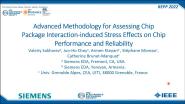3,107 resources related to
Emp
Read more
Featured Article
Read more
Top Conferences on Emp
2022 IEEE International Symposium on Electromagnetic Compatibility & Signal/Power Integrity (EMCSI)
2022 14th Global Symposium on Millimeter-Waves & Terahertz (GSMM)
2021 IEEE International Conference on Plasma Science (ICOPS)
2021 IEEE Asia-Pacific Microwave Conference (APMC)
2019 IEEE 28th International Symposium on Industrial Electronics (ISIE)
2019 IEEE/RSJ International Conference on Intelligent Robots and Systems (IROS)
2019 IEEE Photonics Conference (IPC)
2019 IEEE Avionics and Vehicle Fiber-Optics and Photonics Conference (AVFOP)
2018 15th International Conference on ElectroMagnetic Interference & Compatibility (INCEMIC)
2018 IEEE International Vacuum Electronics Conference (IVEC)
2018 IEEE 34th International Conference on Data Engineering (ICDE)
2018 IEEE 25th International Conference on Software Analysis, Evolution and Reengineering (SANER)
2018 IEEE International Symposium on Power Line Communications and its Applications (ISPLC)
2018 9th International Particle Accelerator Conference (IPAC)
2017 30th International Vacuum Nanoelectronics Conference (IVNC)
2016 8th International Conference on Ultrawideband and Ultrashort Impulse Signals (UWBUSIS)
2016 IEEE Conference on Electromagnetic Field Computation (CEFC)
2016 Sixth International Conference on Instrumentation & Measurement, Computer, Communication and Control (IMCCC)
2015 7th Asia-Pacific Conference on Environmental Electromagnetics (CEEM)
2015 IEEE 5th International Conference on Power Engineering, Energy and Electrical Drives (POWERENG)
2015 25th International Crimean Conference "Microwave and Telecommunication Technology" (CriMiCo)
2012 3rd International Conference on Mechanic Automation and Control Engineering (MACE)
2012 5th International Beijing Symposium on Electromagnetic Compatibility (EMC)
2011 7th Asia-Pacific International Conference on Lightning (APL)
2011 Fifth International Conference on Communication System Software and Middleware (COMSWARE)
2011 International Conference on Web Information Systems and Mining (WISM)
2010 International Conference on Computer, Mechatronics, Control and Electronic Engineering (CMCE 2010)
2009 20th International Zurich Symposium on Electromagnetic Compatibility
2009 International Symposium on Electromagnetic Compatibility, Kyoto (EMC 2009 Kyoto)
2006 International Symposium on Electromagnetic Compatibility - EMC EUROPE
More links
Top Videos on Emp

Xplore Articles related to Emp
Periodicals related to Emp
Power Electronics, IEEE Transactions on
More links
E-books related to Emp
Standards related to Emp
American National Standard Dictionary for Technologies of Electromagnetic Compatibility (EMC), Electromagnetic Pulse (EMP) and Electrostatic Discharge (ESD) (Dictionary of EMC/EMP/ESD Terms and Definitions)
More links
